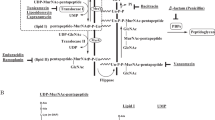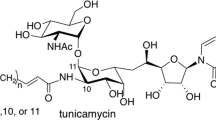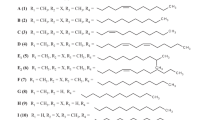Abstract
Antibiotic-resistant bacterial infection is a serious threat to public health. Peptidoglycan biosynthesis is a well-established target for antibiotic development. MraY (phospho-MurNAc-pentapeptide translocase) catalyses the first and an essential membrane step of peptidoglycan biosynthesis. It is considered a very promising target for the development of new antibiotics, as many naturally occurring nucleoside inhibitors with antibacterial activity target this enzyme1,2,3,4. However, antibiotics targeting MraY have not been developed for clinical use, mainly owing to a lack of structural insight into inhibition of this enzyme. Here we present the crystal structure of MraY from Aquifex aeolicus (MraYAA) in complex with its naturally occurring inhibitor, muraymycin D2 (MD2). We show that after binding MD2, MraYAA undergoes remarkably large conformational rearrangements near the active site, which lead to the formation of a nucleoside-binding pocket and a peptide-binding site. MD2 binds the nucleoside-binding pocket like a two-pronged plug inserting into a socket. Further interactions it makes in the adjacent peptide-binding site anchor MD2 to and enhance its affinity for MraYAA. Surprisingly, MD2 does not interact with three acidic residues or the Mg2+ cofactor required for catalysis, suggesting that MD2 binds to MraYAA in a manner that overlaps with, but is distinct from, its natural substrate, UDP-MurNAc-pentapeptide. We have determined the principles of MD2 binding to MraYAA, including how it avoids the need for pyrophosphate and sugar moieties, which are essential features for substrate binding. The conformational plasticity of MraY could be the reason that it is the target of many structurally distinct inhibitors. These findings can inform the design of new inhibitors targeting MraY as well as its paralogues, WecA and TarO.
This is a preview of subscription content, access via your institution
Access options
Subscribe to this journal
Receive 51 print issues and online access
$199.00 per year
only $3.90 per issue
Buy this article
- Purchase on Springer Link
- Instant access to full article PDF
Prices may be subject to local taxes which are calculated during checkout




Similar content being viewed by others
References
Bouhss, A., Trunkfield, A. E., Bugg, T. D. & Mengin-Lecreulx, D. The biosynthesis of peptidoglycan lipid-linked intermediates. FEMS Microbiol. Rev. 32, 208–233 (2008)
Bugg, T. D., Lloyd, A. J. & Roper, D. I. Phospho-MurNAc-pentapeptide translocase (MraY) as a target for antibacterial agents and antibacterial proteins. Infect. Disord. Drug Targets 6, 85–106 (2006)
Lecerclé, D. et al. Bacterial transferase MraY inhibitors: synthesis and biological evaluation. Bioorg. Med. Chem. 18, 4560–4569 (2010)
Shapiro, A. B., Jahic, H., Gao, N., Hajec, L. & Rivin, O. A high-throughput, homogeneous, fluorescence resonance energy transfer-based assay for phospho-N-acetylmuramoyl-pentapeptide translocase (MraY). J. Biomol. Screen. 17, 662–672 (2012)
Walsh, C. T. & Zhang, W. Chemical logic and enzymatic machinery for biological assembly of peptidyl nucleoside antibiotics. ACS Chem. Biol. 6, 1000–1007 (2011)
Winn, M., Goss, R. J., Kimura, K. & Bugg, T. D. Antimicrobial nucleoside antibiotics targeting cell wall assembly: recent advances in structure-function studies and nucleoside biosynthesis. Nat. Prod. Rep. 27, 279–304 (2010)
Brandish, P. E. et al. Modes of action of tunicamycin, liposidomycin B, and mureidomycin A: inhibition of phospho-N-acetylmuramyl-pentapeptide translocase from Escherichia coli . Antimicrob. Agents Chemother. 40, 1640–1644 (1996)
Bernhardt, T. G., Struck, D. K. & Young, R. The lysis protein E of ϕX174 is a specific inhibitor of the MraY-catalyzed step in peptidoglycan synthesis. J. Biol. Chem. 276, 6093–6097 (2001)
Bogatcheva, E. et al. Chemical modification of capuramycins to enhance antibacterial activity. J. Antimicrob. Chemother. 66, 578–587 (2011)
Koga, T. et al. Activity of capuramycin analogues against Mycobacterium tuberculosis, Mycobacterium avium and Mycobacterium intracellulare in vitro and in vivo. J. Antimicrob. Chemother. 54, 755–760 (2004)
McDonald, L. A. et al. Structures of the muraymycins, novel peptidoglycan biosynthesis inhibitors. J. Am. Chem. Soc. 124, 10260–10261 (2002)
Nikonenko, B. V. et al. Activity of SQ641, a capuramycin analog, in a murine model of tuberculosis. Antimicrob. Agents Chemother. 53, 3138–3139 (2009)
Takeoka, Y. et al. Expansion of antibacterial spectrum of muraymycins toward Pseudomonas aeruginosa . ACS Med. Chem. Lett. 5, 556–560 (2014)
Tanino, T. et al. Mechanistic analysis of muraymycin analogues: a guide to the design of MraY inhibitors. J. Med. Chem. 54, 8421–8439 (2011)
Tanino, T. et al. Synthesis and biological evaluation of muraymycin analogues active against anti-drug-resistant bacteria. ACS Med. Chem. Lett. 1, 258–262 (2010)
Tanino, T., Ichikawa, S. & Matsuda, A. Synthesis of l-epi-capreomycidine derivatives via C-H amination. Org. Lett. 13, 4028–4031 (2011)
Tanino, T., Ichikawa, S., Shiro, M. & Matsuda, A. Total synthesis of (−)-muraymycin D2 and its epimer. J. Org. Chem. 75, 1366–1377 (2010)
Yamashita, A. et al. Muraymycins, novel peptidoglycan biosynthesis inhibitors: synthesis and SAR of their analogues. Bioorg. Med. Chem. Lett. 13, 3345–3350 (2003)
Lloyd, A. J., Brandish, P. E., Gilbey, A. M. & Bugg, T. D. Phospho-N-acetyl-muramyl-pentapeptide translocase from Escherichia coli: catalytic role of conserved aspartic acid residues. J. Bacteriol. 186, 1747–1757 (2004)
Mengin-Lecreulx, D., Flouret, B. & van Heijenoort, J. Cytoplasmic steps of peptidoglycan synthesis in Escherichia coli. J. Bacteriol. 151, 1109–1117 (1982)
Chung, B. C. et al. Crystal structure of MraY, an essential membrane enzyme for bacterial cell wall synthesis. Science 341, 1012–1016 (2013)
Al-Dabbagh, B. et al. Active site mapping of MraY, a member of the polyprenyl-phosphate N-acetylhexosamine 1-phosphate transferase superfamily, catalyzing the first membrane step of peptidoglycan biosynthesis. Biochemistry 47, 8919–8928 (2008)
Price, N. P. & Momany, F. A. Modeling bacterial UDP-HexNAc: polyprenol-P HexNAc-1-P transferases. Glycobiology 15, 29R–42R (2005)
Izumi, M., Yuasa, H. & Hashimoto, H. Bisubstrate analogues as glycosyltransferase inhibitors. Curr. Top. Med. Chem. 9, 87–105 (2009)
Wang, R. et al. A search for pyrophosphate mimics for the development of substrates and inhibitors of glycosyltransferases. Bioorg. Med. Chem. 5, 661–672 (1997)
Gloster, T. M. & Vocadlo, D. J. Developing inhibitors of glycan processing enzymes as tools for enabling glycobiology. Nature Chem. Biol. 8, 683–694 (2012)
Rillahan, C. D., Brown, S. J., Register, A. C., Rosen, H. & Paulson, J. C. High-throughput screening for inhibitors of sialyl- and fucosyltransferases. Angew. Chem. Int. Ed. Engl. 50, 12534–12537 (2011)
Rodolis, M. T. et al. Mechanism of action of the uridyl peptide antibiotics: an unexpected link to a protein-protein interaction site in translocase MraY. Chem. Commun. 50, 13023–13025 (2014)
Dini, C. et al. Synthesis of the nucleoside moiety of liposidomycins: elucidation of the pharmacophore of this family of MraY inhibitors. Bioorg. Med. Chem. Lett. 10, 1839–1843 (2000)
Ii, K., Ichikawa, S., Al-Dabbagh, B., Bouhss, A. & Matsuda, A. Function-oriented synthesis of simplified caprazamycins: discovery of oxazolidine-containing uridine derivatives as antibacterial agents against drug-resistant bacteria. J. Med. Chem. 53, 3793–3813 (2010)
McCoy, A. J. et al. Phaser crystallographic software. J. Appl. Crystallogr. 40, 658–674 (2007)
Adams, P. D. et al. PHENIX: a comprehensive Python-based system for macromolecular structure solution. Acta Crystallogr. D 66, 213–221 (2010)
Emsley, P. & Cowtan, K. Coot: model-building tools for molecular graphics. Acta Crystallogr. D 60, 2126–2132 (2004)
Clarke, T. B. et al. Mutational analysis of the substrate specificity of Escherichia coli penicillin binding protein 4. Biochemistry 48, 2675–2683 (2009)
Dini, C. et al. Synthesis of sub-micromolar inhibitors of MraY by exploring the region originally occupied by the diazepanone ring in the liposidomycin structure. Bioorg. Med. Chem. Lett. 12, 1209–1213 (2002)
Hirano, S., Ichikawa, S. & Matsuda, A. Total synthesis of caprazol, a core structure of the caprazamycin antituberculosis antibiotics. Angew. Chem. Int. Ed. Engl. 44, 1854–1856 (2005)
Acknowledgements
Data for this study were collected at beamlines NE-CAT 24-ID-C and SER-CAT 22-ID-D and at the Advanced Photon Source. We thank K. Yokoyama for advice and guidance throughout the project and Z. Johnson for manuscript reading. Initial X-ray screening of crystals was performed at the Duke macromolecular crystallography facility. This work was supported by NIH R01 GM100984 (S.-Y.L.) and Duke startup funds (S.-Y.L.). This work was also supported by the JSPS Grant-in-Aid for Scientific Research on Innovative Areas ‘Chemical Biology of Natural Products’ (S.I., grant number 24102502) and Scientific Research (B) (S.I., grant number 25293026).
Author information
Authors and Affiliations
Contributions
B.C.C. solved the structure and performed some of ITC experiments and E.H.M. carried out the enzymatic assays and performed most of ITC experiments, both under the guidance of S.-Y.L. T.T. carried out chemical synthesis of MD2 under the guidance of S.I. and A.M. M.K. synthesized 5-aminoribosyl-3-deoxyuridine under the guidance of J.H. S.-Y.L., E.H.M. and B.C.C. wrote the paper. All authors discussed the results and commented on the manuscript.
Corresponding author
Ethics declarations
Competing interests
The authors declare no competing financial interests.
Extended data figures and tables
Extended Data Figure 1 MraY catalyses the formation of lipid I and binds MD2.
a, Scheme of the reaction catalysed by MraY. The U-labelled blue hexagon represents uridine and the M-labelled orange hexagon represents MurNAc. The phosphates associated with the lipid carrier C55-P are shown as red circles, and the phosphates from the substrate, UM5A, are shown as yellow circles. b, Chemical structures of the substrate, UM5A (top) and the inhibitor MD2 (bottom). c, Michaelis–Menten kinetic characterization of MraYAA translocase activity. The reaction monitored is the MraYAA-catalysed transfer of [14C]phospho-MurNAc-pentapeptide from [14C]UM5A to C55-P, forming [14C]lipid I. The enzymatic parameters measured are as follows: Km = 190 ± 60 μM, kcat = 20 ± 2 min−1, kcat/Km = 0.11 ± 0.3 μM−1 min−1. Data are mean and s.e.m. of three technical replicates. d, MD2 (green) in complex with MraYAA. The distances between MD2 and the three catalytic acidic residues Asp117, Asp118 and Asp265 (magenta) are all greater than 4.5 Å.
Extended Data Figure 2 Conformational changes of the TM9b and loop E region of MraYAA upon MD2 binding.
a, Zoomed-in view of TM9b (yellow) and loop E (salmon) of apoMraYAA, viewed from within the membrane. b, TM9b and loop E of MD2-bound MraYAA viewed from within the membrane. MD2 is omitted to illustrate the conformational change of TM9b and loop E associated with MD2 binding. Conserved amino acid residues and their interactions are shown in stick representation as dotted lines, respectively. c, 45° rotated view of a about a horizontal axis. d, 45° rotated view of b about a horizontal axis, including the model of MD2 (green). The rotation of TM9b and rearrangement of loop E, including the HHH motif, allows for MD2 binding, especially its peptidic moiety.
Extended Data Figure 3 Quality of electron density map surrounding MD2.
a, Stereo view of 2Fo − Fc electron density map at 1σ for TM9b and loop E. b, Stereo view of 2Fo− Fc electron density map at 1σ for the MD2 binding pocket. The electron density peaks corresponding to MD2 are carved for clarity and all transmembrane helices are coloured as in Fig. 3.
Extended Data Figure 4 Conformational changes in MraYAA that create binding pockets for the uridine and 5-aminoribosyl groups of MD2.
a, A close-up view of apoMraYAA with key residues that participate in conformational changes upon MD2 binding shown as sticks in various colours. b, A close-up view of the nucleoside-binding pocket in the MraYAA–MD2 complex with MD2 omitted. Key residues are coloured as in a. c, A close-up view of the interactions MD2 (green) makes with the nucleoside-binding pocket of MraYAA. Interactions between MraYAA and MD2 are shown as dotted lines. It is noteworthy that residues interacting with the uridine moiety of MD2 move large distances (5–17 Å for residues Lys70, Asp196, Asn255 and Phe262), while the residues binding the 5-aminoribosyl group of MD2 (Thr75, Asn190 and Asp193) do not make large side-chain movements after MD2 binding. The uridine and 5-amino ribosyl groups of MD2 are circled. d, Interactions between the uracil base of MD2 (green) and the nucleoside-binding pocket of MraYAA. The uracil base forms H-bonds with side chains of Asn255, Asp196 and Lys70 and forms a π–π interaction with Phe262. d, The 5-aminoribosyl group of MD2 forms H-bond interactions with side chains of Thr75, Asn190 and Asp193, and the backbone amide of Gly264.
Extended Data Figure 5 Specific activity of wild-type and mutant MraYAA in the presence and absence of MD2.
a, Normalized specific activity of wild-type (WT) MraYAA and enzymatically active mutants with and without MD2 treatment. Wild-type MraYAA or mutant MraYAA was added to the reaction mixture to a final concentration that enabled product detection within the enzymatic linear range: 50 nM (WT), 500 nM (Lys70Ala), 400 nM (Thr75Ala), 350 nM (Asp193Asn), 250 nM (Asn255Ala), 200 nM (Phe262Ala), 50 nM (Phe262Trp), 400 nM (Gln305Ala), and 500 nM (His325Ala). Each reaction was carried out in the presence of either 0 μM, 0.3 μM or 1 μM MD2. Data are shown for three technical replicates ± s.e.m. Specific activity measurements for each mutant were normalized relative to that without added MD2. b, Specific activity of wild-type MraYAA and enzymatically inactive mutants. MraYAA Asn190Ala, Asp193Ala, Asp196Ala and Asp196Asn were each added to a final concentration of 500 nM, while wild-type MraYAA was present at 50 nM. All enzymatic reactions were conducted with a radiochemical assay monitoring the transfer of [14C]phospho-MurNAc-pentapeptide from [14C]UM5A to C55-P, forming [14C]lipid I. The radiolabelled product, [14C]lipid I, was quantified using a liquid scintillation counting method (d.p.m.). Specific activity was calculated by determining moles of [14C]lipid I formed, divided by the reaction time and the quantity of enzyme added. Three technical replicates are shown with the mean value indicated by a line.
Extended Data Figure 6 Representative ITC raw data and binding isotherms for MD2 interacting with mutant MraYAA.
All titrations were performed in triplicate (technical replicates); see source data for all titrations. Representative data are shown. For MraYAA mutants Lys70Ala, Thr75Ala, Asp193Asn, Asn255Ala, Phe262Trp and His325Ala, 210 μM MD2 was titrated into 30 μM enzyme. For MraYAA Gln305Ala, 315–430 μM MD2 was titrated into 25–27 μM enzyme. For MraYAA Phe262Ala, 80–110 μM MD2 was titrated into 7–10.5 μM enzyme. Mean thermodynamic parameters for triplicate titrations are shown in the Extended Data Table 2. Mean Kd values for each triplicate are as follows: 63.9 ± 4.7 nM for Lys70Ala; 27.4 ± 1.5 nM for Thr75Ala; Kd not determined for Asp193Asn; 29.7 ± 0.8 nM for Asn255Ala; 228 ± 4 nM for Phe262Ala; 68.4 ± 0.9 nM for Phe262Trp; 117 ± 10 nM for Gln305Ala; 24.4 ± 0.4 nM for His325Ala.
Supplementary information
Supplementary Data
This file contains Source Data for Extended Data Table 2. (XLSX 205 kb)
The conformational changes MraYAA undergoes upon binding its inhibitor, muraymycin D2 (MD2).
MD2 is shown in cyan sticks. Residues interacting with substructures of MD2 are colored as follows: uridine (red), 5-amino ribose (blue), peptidic sidechain (yellow). (MP4 3088 kb)
Rights and permissions
About this article
Cite this article
Chung, B., Mashalidis, E., Tanino, T. et al. Structural insights into inhibition of lipid I production in bacterial cell wall synthesis. Nature 533, 557–560 (2016). https://doi.org/10.1038/nature17636
Received:
Accepted:
Published:
Issue Date:
DOI: https://doi.org/10.1038/nature17636
This article is cited by
-
Peptidoglycan biosynthesis is driven by lipid transfer along enzyme-substrate affinity gradients
Nature Communications (2022)
-
Synthesis of macrocyclic nucleoside antibacterials and their interactions with MraY
Nature Communications (2022)
-
Chemical logic of MraY inhibition by antibacterial nucleoside natural products
Nature Communications (2019)
-
Visualizing conformation transitions of the Lipid II flippase MurJ
Nature Communications (2019)
-
Engineering nucleoside antibiotics toward the development of novel antimicrobial agents
The Journal of Antibiotics (2019)
Comments
By submitting a comment you agree to abide by our Terms and Community Guidelines. If you find something abusive or that does not comply with our terms or guidelines please flag it as inappropriate.



